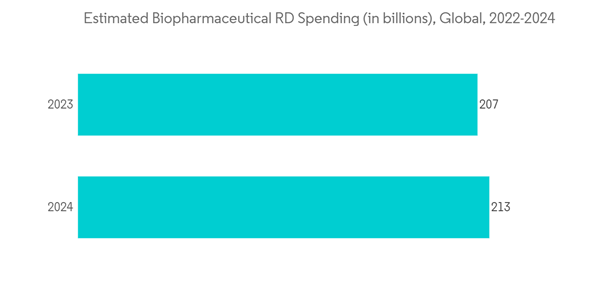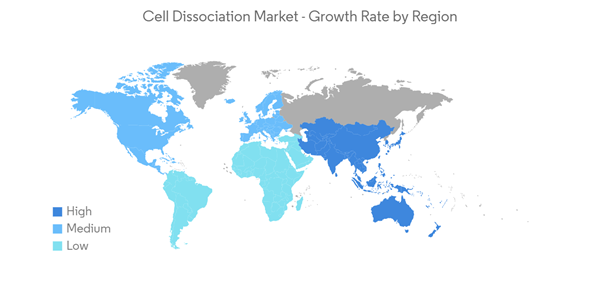The cell dissociation market is valued at USD 0.53 billion in 2024 and is expected to reach USD 1.08 billion by 2029, registering a CAGR of 15.17% over the forecast period (2024-2029).
The COVID-19 pandemic had a significant impact on the market studied. As most pharmaceutical companies focused on therapeutics for COVID-19 infection, the production of cell dissociation enzymes decreased significantly during the pandemic. However, the market has reached its pre-pandemic nature and isure and is expected to witness strong growth over the forecast period.
Key factors responsible for the market growth include increasing R&D activities in biopharmaceutical companies and favorable funding for cancer research globally.
The increase in research and development spending in the biopharmaceutical sector aided in the market's growth. For example, according to 'The Pharmaceutical Industry and Global Health Facts and Figures 2021' published by the International Federation of Pharmaceutical Manufacturers & Associations, the annual research and development spending of the biopharmaceutical industry has been 7.3 times greater than that of the aerospace and defense, industries, 6.5 times more than that the chemicals industry, and 1.5 times more than that of the software and computer services industry. The report further stated that in, 2022 over USD 202 billion was estimated to be spent worldwide on biopharmaceutical research and development. Hence, with strong investments in R&D activities and a pipeline of therapeutics under development, cell dissociation is expected to grow significantly.
Various companies are investing in the research and development of biopharmaceuticals. For instance, in September 2022, Marinus Pharmaceuticals exercised the first contract option by the Biomedical Advanced Research and Development Authority (BARDA) valued at approximately USD 12.3 million, to support the United States onshoring of the manufacturing capabilities for ganaxolone. Furthermore, the new investments in the research and development of biologics by the major market players increase the research activity in producing new biologics. They are expected to drive the market to grow. For instance, in September 2022, Novartis invested in next-generation biotherapeutics to grow its biologics manufacturing and development operations. Hence, with huge R&D investments, the market studied is expected to grow strongly in the coming years.
However, the high cost of tissue- and cell-based procedures is expected to restrain the market growth over the forecast period.
In recent years, there has been a growing demand for biopharmaceuticals due to surging cases of cancer and other life-threatening diseases. There has been a rise in the demand for targeted therapies in recent years. For instance, an article by Pharmaceutical Technology, updated in August 2021, indicated that innovative, novel biologics help in the growth of the biopharmaceutical market, as improved processes and technological developments are aiding in changing the future of manufacturing. Manufacturers of biosimilars are offering less expensive alternatives to many of the monoclonal antibody medications that generate the most revenue in the market at reduced clinical and R&D expenditures.
Also, an article from PubMed published in March 2022 indicated an increase in the demand for biopharmaceuticals, which had prompted the emergence of a business model called 'contract development manufacturing organization (CDMO)' that aids in the development and manufacturing processes. The CDMOs could efficiently manufacture larger volumes of the required biopharmaceutical product, meeting the increasing demands.
Thus, owing to these factors, the segment is expected to grow significantly over the forecast period.
According to the Cancer Facts & Figures 2023 data published by the American Cancer Society, an estimated 1.9 million new cancer cases will be diagnosed and 0.6 million cancer deaths in the United States (US) in 2023. In addition, in the US, the population aged 65 or more was 54.1 million (16% of the total population) in 2019, estimated at 21.6% by 2040. Hence, the prevalence of chronic diseases coupled with the increasing geriatric population in the country is anticipated to create more opportunities for developing new biopharmaceuticals, driving the studied market growth.
Moreover, the incidence of Cancer, cardiovascular diseases (CVDs), and diabetes creates demand for new biopharmaceuticals. For instance, as per the Canadian Cancer Statistics 2021 released in November 2021, an estimated 229,200 Canadians were diagnosed with Cancer in 2021. Also, according to the estimates, the death rates for the three leading cancer types in 2021 were lung cancer (25%), colorectal Cancer (11%), and pancreatic Cancer (7%). With these estimates, it was reported that Cancer remained one of Canada's leading causes of death in 2021. Thus creating opportunities for new therapies in the country and driving the studied market growth.
This product will be delivered within 2 business days.
The COVID-19 pandemic had a significant impact on the market studied. As most pharmaceutical companies focused on therapeutics for COVID-19 infection, the production of cell dissociation enzymes decreased significantly during the pandemic. However, the market has reached its pre-pandemic nature and isure and is expected to witness strong growth over the forecast period.
Key factors responsible for the market growth include increasing R&D activities in biopharmaceutical companies and favorable funding for cancer research globally.
The increase in research and development spending in the biopharmaceutical sector aided in the market's growth. For example, according to 'The Pharmaceutical Industry and Global Health Facts and Figures 2021' published by the International Federation of Pharmaceutical Manufacturers & Associations, the annual research and development spending of the biopharmaceutical industry has been 7.3 times greater than that of the aerospace and defense, industries, 6.5 times more than that the chemicals industry, and 1.5 times more than that of the software and computer services industry. The report further stated that in, 2022 over USD 202 billion was estimated to be spent worldwide on biopharmaceutical research and development. Hence, with strong investments in R&D activities and a pipeline of therapeutics under development, cell dissociation is expected to grow significantly.
Various companies are investing in the research and development of biopharmaceuticals. For instance, in September 2022, Marinus Pharmaceuticals exercised the first contract option by the Biomedical Advanced Research and Development Authority (BARDA) valued at approximately USD 12.3 million, to support the United States onshoring of the manufacturing capabilities for ganaxolone. Furthermore, the new investments in the research and development of biologics by the major market players increase the research activity in producing new biologics. They are expected to drive the market to grow. For instance, in September 2022, Novartis invested in next-generation biotherapeutics to grow its biologics manufacturing and development operations. Hence, with huge R&D investments, the market studied is expected to grow strongly in the coming years.
However, the high cost of tissue- and cell-based procedures is expected to restrain the market growth over the forecast period.
Cell Dissociation Market Trends
Pharmaceutical and Biotechnology Companies Segment is Expected to Witness a Healthy Growth Over the Forecast Period
The increasing focus of biopharmaceutical companies on new drug development and increasing R&D is augmenting the demand for cell dissociation across such companies.In recent years, there has been a growing demand for biopharmaceuticals due to surging cases of cancer and other life-threatening diseases. There has been a rise in the demand for targeted therapies in recent years. For instance, an article by Pharmaceutical Technology, updated in August 2021, indicated that innovative, novel biologics help in the growth of the biopharmaceutical market, as improved processes and technological developments are aiding in changing the future of manufacturing. Manufacturers of biosimilars are offering less expensive alternatives to many of the monoclonal antibody medications that generate the most revenue in the market at reduced clinical and R&D expenditures.
Also, an article from PubMed published in March 2022 indicated an increase in the demand for biopharmaceuticals, which had prompted the emergence of a business model called 'contract development manufacturing organization (CDMO)' that aids in the development and manufacturing processes. The CDMOs could efficiently manufacture larger volumes of the required biopharmaceutical product, meeting the increasing demands.
Thus, owing to these factors, the segment is expected to grow significantly over the forecast period.
North America is Expected to Hold Significant Share of the Market
The cell dissociation market in the North American region is expected to witness significant growth owing to factors such as the highly advanced biopharmaceutical industry, which allows extensive R&D of novel therapeutics and increasing company investment to develop new therapies.According to the Cancer Facts & Figures 2023 data published by the American Cancer Society, an estimated 1.9 million new cancer cases will be diagnosed and 0.6 million cancer deaths in the United States (US) in 2023. In addition, in the US, the population aged 65 or more was 54.1 million (16% of the total population) in 2019, estimated at 21.6% by 2040. Hence, the prevalence of chronic diseases coupled with the increasing geriatric population in the country is anticipated to create more opportunities for developing new biopharmaceuticals, driving the studied market growth.
Moreover, the incidence of Cancer, cardiovascular diseases (CVDs), and diabetes creates demand for new biopharmaceuticals. For instance, as per the Canadian Cancer Statistics 2021 released in November 2021, an estimated 229,200 Canadians were diagnosed with Cancer in 2021. Also, according to the estimates, the death rates for the three leading cancer types in 2021 were lung cancer (25%), colorectal Cancer (11%), and pancreatic Cancer (7%). With these estimates, it was reported that Cancer remained one of Canada's leading causes of death in 2021. Thus creating opportunities for new therapies in the country and driving the studied market growth.
Cell Dissociation Industry Overview
The cell dissociation market studied is moderately competitive, and several local and international players are posing intense competition across various geographies. Most of this market's key players have a good presence in the North America and Europe region. Some European countries, Germany, France, and Italy, are where biotechnology companies are trying to establish their R&D plants. Similarly, the United States is a country where all the companies are generating large revenue due to the high adoption of the technologies and increasing use of cell dissociation.Additional Benefits:
- The market estimate (ME) sheet in Excel format
- 3 months of analyst support
This product will be delivered within 2 business days.
Table of Contents
1 INTRODUCTION
4 MARKET DYNAMICS
5 MARKET SEGMENTATION
6 COMPETITIVE LANDSCAPE
Companies Mentioned (Partial List)
A selection of companies mentioned in this report includes, but is not limited to:
- American Type Culture Collection
- Becton, Dickinson and Company
- F. Hoffmann-La Roche Ltd
- GE Healthcare
- Himedia Laboratories
- Merck KGaA
- Miltenyi Biotec
- Pan-Biotech
- Stemcell Technologies
- Thermo Fisher Scientific
Methodology

LOADING...










